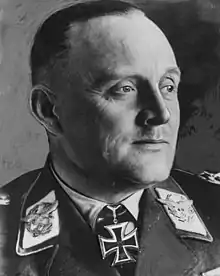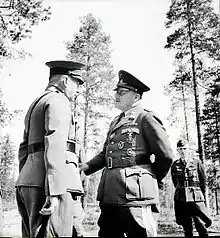Hans-Jürgen Stumpff | |
|---|---|
 | |
| Born | 15 June 1889 Kolberg, German Empire |
| Died | 9 March 1968 (aged 78) Frankfurt am Main, West Germany |
| Allegiance | |
| Service/ | |
| Years of service | 1907–1945 |
| Rank | |
| Commands held | Chief of the Luftwaffe General Staff Luftflotte Reich Luftflotte 5 |
| Battles/wars | World War I |
| Awards | Knight's Cross of the Iron Cross |
| Relations | Horst Stumpff (brother) |
Hans-Jürgen Stumpff (15 June 1889 – 9 March 1968), was a German general during World War II and was one of the signatories to Germany's unconditional surrender at the end of the war.
Military career

Stumpff joined the army in 1907 and served on the General Staff during World War I. During the Weimar Republic, he served as a staff officer in the Reichswehrministerium. On 1 September 1933, Stumpff, with the rank of lieutenant colonel, became head of personnel in the (illegal) Luftwaffe. After the Luftwaffe became formally legal in Germany because of the Nazis rejection of the terms of the Treaty of Versailles, Stumpff served as its chief of staff from 1 June 1937 until 1 January 1939. In 1938, Stumpff was promoted to the rank of General der Flieger.
During the Second World War, Stumpff commanded various Luftflotten. On 19 July 1940, Stumpff was promoted to the rank of Generaloberst and awarded the Knight's Cross of the Iron Cross. Until the end of 1943 Stumpff commanded Luftflotte 5, with which he took part in the Battle of Britain, operating out of Norway against Scotland and Northern England. Stumpff was a recipient of the Knight's Cross of the Iron Cross of Nazi Germany.
In January 1944, Stumpff commanded Luftwaffe forces in the Defense of the Reich campaign against the Allied bombing attacks. On 8 May 1945, Stumpff served as the Luftwaffe representative at the signing of the unconditional surrender of Germany in Berlin. Stumpff was released from British captivity in 1947; he died in 1968.
Awards and decorations
- Knight's Cross of the Iron Cross on 18 September 1941 as Generaloberst and Chief of Luftflotte 5 and Befehlshaber Nord (commander-in-chief north)[1]
- Grand Cross with Swords of the Order of the White Rose of Finland on 27 October 1941 as Generaloberst[2]
References
Bibliography
- Matikkala, Antti (2017). Kunnian ruletti: Korkeimmat ulkomaalaisille 1941–1944 annetut suomalaiset kunniamerkit [The Roulette of Honour: The Highest Finnish Orders to Foreigners 1941–1944] (in Finnish). Helsinki: Suomalaisen Kirjallisuuden Seura. ISBN 978-952-222-847-5.
- Scherzer, Veit (2007). Die Ritterkreuzträger 1939–1945 Die Inhaber des Ritterkreuzes des Eisernen Kreuzes 1939 von Heer, Luftwaffe, Kriegsmarine, Waffen-SS, Volkssturm sowie mit Deutschland verbündeter Streitkräfte nach den Unterlagen des Bundesarchives [The Knight's Cross Bearers 1939–1945 The Holders of the Knight's Cross of the Iron Cross 1939 by Army, Air Force, Navy, Waffen-SS, Volkssturm and Allied Forces with Germany According to the Documents of the Federal Archives] (in German). Jena, Germany: Scherzers Militaer-Verlag. ISBN 978-3-938845-17-2.